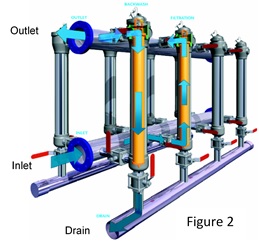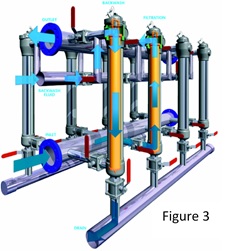A Filtration System Design By and For Papermakers
 Pressure filters are used extensively in the papermaking process and often go unnoticed as they effortlessly operate in stable mill water systems. They quietly perform as designed preventing shower nozzles from plugging and assuring that paper machine clothing remains clean. Pressure filters protect process equipment by removing contaminants such as sand and silt from mill water. The water quality of chemical dilution water improves, and fiber and felt hair is removed from size press starch preventing sheet defects.
Pressure filters are used extensively in the papermaking process and often go unnoticed as they effortlessly operate in stable mill water systems. They quietly perform as designed preventing shower nozzles from plugging and assuring that paper machine clothing remains clean. Pressure filters protect process equipment by removing contaminants such as sand and silt from mill water. The water quality of chemical dilution water improves, and fiber and felt hair is removed from size press starch preventing sheet defects.
However, it is an entirely different story when the river or mill white water system upsets. Maintenance personnel many times devote full attention to servicing pressure filters, including the disassembly and cleaning of filter systems that backflush automatically, until the process is stabilized.
A brief review of pressure filtration theory
The pressure filter may be one of the most misunderstood pieces of equipment in the mill. It belongs to a class of filters known as “polishing filters” which are designed to remove trace amounts of suspended solids from liquids. Depending on the micron retention of the screen and the total amount of filtration surface area, a typical filter element will retain between 0.05-1.0 lbs of debris before cleaning is required.
For example, if a filter removes 5 ppm of solids from a 100 gpm flow of water, it will collect 6 pounds of solids daily. If the screen holding capacity is 0.5 lbs of solids, the screen will require cleaning every two hours or 12 times per day. The fact that a pressure filter removes a very small amount of material is not always apparent without this mathematical explanation. However, what is understood is it only takes one tiny fiber to plug a shower nozzle causing product defects which can be costly to the mill.
 Figure 1 illustrates the flow path of a typical single tube pressure filter. Liquid enters on the left, clean liquid exits on the right, and debris and contaminants remain on the outside of the filter medium. As the filter cake accumulates, differential pressure measured from the inlet to the outlet of the filter increases until a predetermined value (typically 10-20 psid) is reached and cleaning is required. The cleaning operation can be one of three methods:
Figure 1 illustrates the flow path of a typical single tube pressure filter. Liquid enters on the left, clean liquid exits on the right, and debris and contaminants remain on the outside of the filter medium. As the filter cake accumulates, differential pressure measured from the inlet to the outlet of the filter increases until a predetermined value (typically 10-20 psid) is reached and cleaning is required. The cleaning operation can be one of three methods:
- Manual clean - requires removal of the filter element from the housing.
- Internal backwash - clean filtered process water is used to flush contaminants to drain (shown in figure 2).
- External backwash - uses an outside liquid source to flush contaminants to drain (shown in figure 3).
Both internal and external filters are typically backwashed automatically without operator attention.
In situations when the process is upset, the filter screens may remove too many solids too quickly. The automatic cleaning cycle that is initiated on differential pressure may be unable to backwash the filter frequently enough and the screens will require removal and manual cleaning. The filter is doing exactly what it is supposed to but is being asked to do more than it is designed to do.
 At one paper mill, Kadant identified an opportunity to eliminate a service step and make the filter element removal easier thereby reducing mill maintenance costs associated with servicing its filters. As a result, the ErGo™ filtration system was developed. The ErGo filtration system is designed to satisfy the need for both safety and reduced maintenance. Major features of the design include improved ease of filter element removal, low headroom installation, “bottomless” barrel design, and safe, rapid screen access.
At one paper mill, Kadant identified an opportunity to eliminate a service step and make the filter element removal easier thereby reducing mill maintenance costs associated with servicing its filters. As a result, the ErGo™ filtration system was developed. The ErGo filtration system is designed to satisfy the need for both safety and reduced maintenance. Major features of the design include improved ease of filter element removal, low headroom installation, “bottomless” barrel design, and safe, rapid screen access.
Learn more about the Ergo filtration system and other pressure filters available from Kadant.
